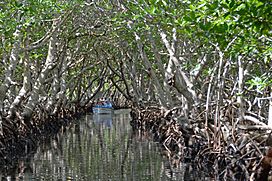Northern Honduras mangroves facts for kids
Quick facts for kids Northern Honduras mangroves |
|
|---|---|

Mangroves in Roatán, Honduras.
|
|
| Ecology | |
| Biome | Mangroves |
| Geography | |
| Area | 1,036 km2 (400 sq mi) |
| Countries | Honduras and Guatemala |
| Conservation | |
| Conservation status | Vulnerable |
The Northern Honduras mangroves are a special natural area. They are a type of ecoregion, which is a large area of land or water with unique plants and animals. This ecoregion is part of the mangroves biome. A biome is a major natural habitat, like a forest or a desert. The World Wildlife Fund describes this area.
These mangroves stretch along most of the Caribbean coast of Honduras. They also reach into the eastern part of Amatique Bay in Guatemala. This important natural space covers about 1036 square kilometers. Sadly, this ecoregion is facing threats. Farms and livestock production are growing, which can harm these valuable mangrove forests.
Contents
What are Mangroves?
Mangroves are amazing trees and shrubs. They grow in salty water along coastlines. You can find them in tropical and subtropical areas. They have special roots that help them breathe in muddy, low-oxygen soil. These roots also help them stand firm against waves.
Mangrove forests are very important for our planet. They protect coastlines from storms and erosion. They also act like natural filters, cleaning the water. Many different animals call these forests home.
Where are the Northern Honduras Mangroves?
This ecoregion is located in Central America. It runs along the Caribbean Sea. Most of it is in Honduras. A smaller part is in Guatemala. This area has a warm, wet climate. This is perfect for mangroves to grow.
The mangroves grow in coastal lagoons and river deltas. These are places where rivers meet the sea. The mix of fresh and salt water creates a unique environment. This environment is ideal for mangrove trees.
Why are Mangroves Important?
Mangrove forests are like busy cities for wildlife. Many kinds of fish, crabs, and birds live there. Young fish often use mangroves as safe nurseries. They grow there before moving to the open ocean.
These forests also help people. They protect coastal communities from strong winds and waves. They can even reduce the impact of tsunamis. Mangroves also store a lot of carbon. This helps fight climate change. They are truly vital ecosystems.
Threats to Mangrove Forests
The Northern Honduras mangroves are considered vulnerable. This means they are at risk. One big threat is the expansion of human activities. Farms are growing larger. More land is being used for raising livestock. This often means clearing mangrove areas.
Pollution from nearby towns and farms can also harm mangroves. Trash and chemicals can damage the delicate ecosystem. Climate change is another concern. Rising sea levels and stronger storms can also threaten these forests.
Protecting the Mangroves
Many people are working to protect these valuable areas. Conservation groups are raising awareness. They teach people about the importance of mangroves. Efforts are made to create protected areas. These areas help keep the mangroves safe from harm.
Sustainable practices are also important. This means finding ways to use resources without destroying them. For example, promoting responsible fishing helps protect the fish that live in the mangroves. Everyone can help by learning about these amazing forests.
See also
 In Spanish: Manglares del norte de Honduras y Guatemala para niños
In Spanish: Manglares del norte de Honduras y Guatemala para niños

